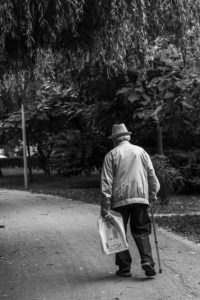 A person with Alzheimer’s disease or another form of dementia might need to move into a specialized care facility for his own safety and medical care. If you have a loved one in this situation, you need to know about the options available for dementia care in assisted living and nursing home facilities.
A person with Alzheimer’s disease or another form of dementia might need to move into a specialized care facility for his own safety and medical care. If you have a loved one in this situation, you need to know about the options available for dementia care in assisted living and nursing home facilities.
The Alzheimer’s Association created practice recommendations for nursing homes and assisted living facilities that offer dementia care for residents. These guidelines focus on six care areas:
- Food and fluid consumption
- Pain management
- Social engagement
- Wandering
- Falls
- Physical restraints
Care Recommendations about Food and Fluid Consumption
People with dementia do not always make good choices about the food and liquid they consume. They might not consume enough to meet their nutritional or hydration needs, or they might consume items with little nutritional value. As a result, their health and comfort can suffer.
Facilities that provide dementia care should:
- Perform initial and routine periodic assessments of each resident’s food and fluid consumption status.
- Develop procedures that ensure the residents consume proper food and liquids.
- Make mealtimes enjoyable events, where staff interact with the residents and assess the food and fluid in a pleasant social setting.
Residents with physical challenges that make eating or drinking difficult should receive assessment by qualified professional specialists.
Pain Management Care Recommendations
Because many people with dementia have difficulty communicating, they under-report their pain and do not receive the treatment they need. Untreated pain is one of the main reasons why nursing home residents develop undesired behavioral symptoms and receive psychotropic drugs to manage their behavior, instead of getting relief from their pain.
Dementia care should include:
- Including pain assessment in every vital signs check, along with pulse, temperature, blood pressure, and respiration. Consider pain as the “fifth vital sign.”
- Routinely treat pain just as one would address problems with any other vital sign.
- Customize the pain management techniques for each resident, taking into account the individual’s risks, medical conditions, needs, and other relevant circumstances.
Appropriate pain management can improve the resident’s quality of life.
Guidelines for Social Engagement
Every day, the facility should offer multiple opportunities for residents with dementia to engage in fun, meaningful social activities. The nursing home or assisted living center should consider each resident’s interests and functional abilities. A roomful of residents sitting in their wheelchairs passively watching a staff member perform an activity has little meaning for them, as compared to an event in which the residents can actively participate.
The home should respect each resident’s preferences, including a desire for solitude or downtime. The staff should never force a resident to participate in an activity.
Recommendations about Wandering
Many people with dementia engage in a behavior called wandering. Often, the resident wanders because he is physically uncomfortable, in emotional distress, is bothered by something in his environment, or is looking for social contact.
Facilities that offer dementia care need to encourage the resident to be mobile and physically active, but provide a safe and independent means for him to do so. Some dementia care facilities have hallways that loop around in a circle, so residents can satisfy the need to walk without ending up far from their rooms.
The center should assess the reasons for the individual’s wandering and try to meet those needs. The facility should also develop protocols that prevent unsafe wandering, including exit seeking.
Guidelines to Prevent Falls
The facility should assess each resident’s risk of falling to prevent injuries. Fall injuries can rob a resident of her mobility. The center should implement measures that reduce the risk of falling. Physical restraints lead to fall injuries. For this and other reasons, nursing homes should avoid the use of physical restraints.
Recommendations on the Use of Physical Restraints
Sometimes a nursing home will use physical restraints under the misguided notion these devices keep residents safe. However, in fact, restraints often harm residents. Facilities should identify the reasons for undesired behavior and address those issues without using restraints. The staff should receive training on restraint-free techniques for keeping residents safe.
Every state has different laws, and your state’s regulations might vary from the general law of this article. You might want to talk to an elder law attorney near you.
References:
National Consumer Voice. “Dementia Care.” (accessed August 15, 2019) https://ltcombudsman.org/issues/dementia-care

